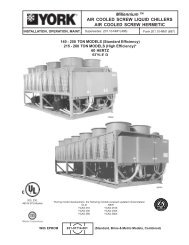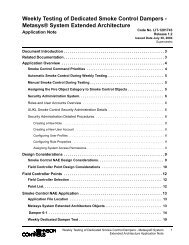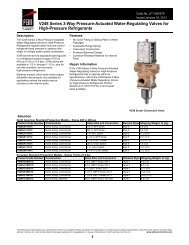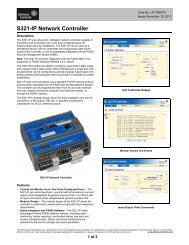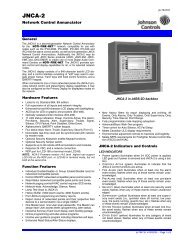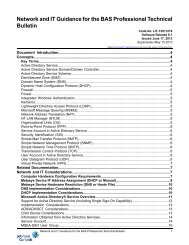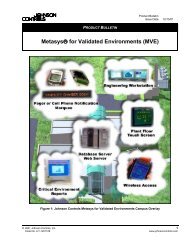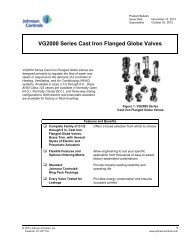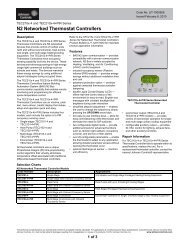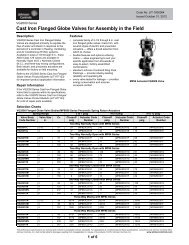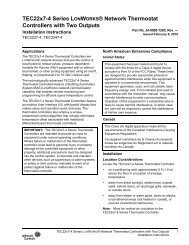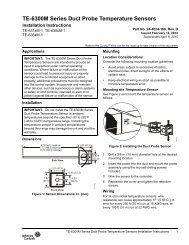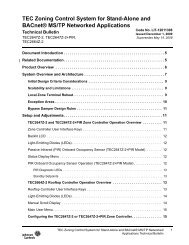YVAA Style A Air-Cooled Screw Liquid Chillers ... - Johnson Controls
YVAA Style A Air-Cooled Screw Liquid Chillers ... - Johnson Controls
YVAA Style A Air-Cooled Screw Liquid Chillers ... - Johnson Controls
You also want an ePaper? Increase the reach of your titles
YUMPU automatically turns print PDFs into web optimized ePapers that Google loves.
SECTION 1 - GENERAL CHILLER INFORMATION AND SAFETY<br />
ETL/ASME marked units conform to the following<br />
standards:<br />
10<br />
• ANSI/ASHRAE 15 – Safety Code for Mechanical<br />
Refrigeration.<br />
• ANSI/ASHRAE 34 – Number Designation and<br />
Safety Classification of Refrigerants.<br />
• ANSI/NFPA 70 – National Electrical Code<br />
(N.E.C.).<br />
• ASME Boiler and Pressure Vessel Code, Section<br />
VIII, Division 1.<br />
GB marked units conform to the following standards:<br />
• GB5226.1 Safety of machinery- Electrical equipment<br />
of machines – Part 1: General requirements.<br />
• GB25131 Safety requirements for water chiller<br />
(heat pump) using the vapor compression cycle.<br />
FLUORINATED GREENHOUSE GASES<br />
• This equipment contains fluorinated greenhouse<br />
gases covered by the Kyoto Protocol.<br />
• The global warming potential of the refrigerant<br />
(RI34a) used in this unit is 1300.<br />
• The refrigerant quantity is stated in Table 4 on<br />
page 50 of this document.<br />
• The fluorinated greenhouse gases in this equipment<br />
may not be vented to the atmosphere.<br />
• This equipment should only be serviced by qualified<br />
technicians.<br />
RESPONSIBILITY FOR SAFETY<br />
Every care has been taken in the design and manufacture<br />
of the unit to ensure compliance with the safety<br />
requirements listed above. However, the individual<br />
operating or working on any machinery is primarily<br />
responsible for:<br />
• Personal safety, safety of other personnel, and the<br />
machinery.<br />
• Correct utilization of the machinery in accordance<br />
with the procedures detailed in the manual.<br />
ABOUT THIS MANUAL<br />
The contents of this manual include suggested best<br />
working practices and procedures. These are issued for<br />
guidance only, and they do not take precedence over<br />
the above stated individual responsibility and/or local<br />
safety regulations.<br />
FORM 201.28-NM1.1<br />
ISSUE DATE: 8/29/2012<br />
This manual and any other document supplied with<br />
the unit are the property of <strong>Johnson</strong> <strong>Controls</strong> which reserves<br />
all rights. They may not be reproduced, in whole<br />
or in part, without prior written authorization from an<br />
authorized <strong>Johnson</strong> <strong>Controls</strong> representative.<br />
MISUSE OF EQUIPMENT<br />
Suitability for Application<br />
The unit is intended for cooling water or glycol solutions<br />
and is not suitable for purposes other than those<br />
specified in these instructions. Any use of the equipment<br />
other than its intended use, or operation of the<br />
equipment contrary to the relevant procedures may result<br />
in injury to the operator, or damage to the equipment.<br />
The unit must not be operated outside the design parameters<br />
specified in this manual.<br />
Structural Support<br />
Structural support of the unit must be provided as indicated<br />
in these instructions. Failure to provide proper<br />
support may result in injury to the operator, or damage<br />
to the equipment and/or building.<br />
Mechanical Strength<br />
The unit is not designed to withstand loads or stresses<br />
from adjacent equipment, pipework or structures. Additional<br />
components must not be mounted on the unit.<br />
Any such extraneous loads may cause structural failure<br />
and may result in injury to the operator, or damage to<br />
the equipment.<br />
General Access<br />
There are a number of areas and features, which may<br />
be a hazard and potentially cause injury when working<br />
on the unit unless suitable safety precautions are taken.<br />
It is important to ensure access to the unit is restricted<br />
to suitably qualified persons who are familiar with the<br />
potential hazards and precautions necessary for safe<br />
operation and maintenance of equipment containing<br />
high temperatures, pressures and voltages.<br />
Pressure Systems<br />
The unit contains refrigerant vapor and liquid under pressure,<br />
release of which can be a danger and cause injury.<br />
The user should ensure that care is taken during installation,<br />
operation and maintenance to avoid damage to the<br />
pressure system. No attempt should be made to gain access<br />
to the component parts of the pressure system other<br />
than by suitably trained and qualified personnel.<br />
JOHNSON CONTROLS



